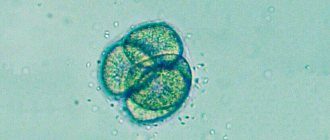In gynecology and obstetrics, there are certain norms regarding female vaginal secretions. It is believed that in the absence of pathological conditions, it should be transparent, released in very small quantities and not cause any discomfort. But we should not forget that every month the organs of the reproductive system go through certain phases that lead to a change in the nature of the mucous secretion. Sometimes it becomes viscous and profuse, and in some cases even contains blood. However, most often women are bothered by discharge like egg white. What does this mean and should you worry when they appear? Let's talk about it.
The nature of discharge before and after ovulation
By its nature, vaginal mucus is a secretion of the female genital organs. Its main composition is the epithelium contained in mucus. The main purpose of these secretions is to moisturize the vagina and create a barrier to protect the reproductive system from infection.
The nature of the secretion in women throughout the menstrual cycle is not constant, its quantity and consistency changes depending on the approach of ovulation. Also, changes in color and odor can occur in the presence of various diseases.
Such deviations may be a sign of pathological processes and require immediate medical intervention. The norm is considered to be mucus, which appears in small quantities and has a slightly cloudy color, similar to egg white due to the presence of epithelial cells.
The appearance of discharge like egg white during ovulation occurs due to changes in hormone levels. They become slippery, reminiscent of egg white, which helps create more favorable conditions for the penetration of sperm into the vagina and their further movement towards the egg. The changes that occur in the excreted cause significant differences in them from those that occur in other phases of the cycle. The appearance of mucus like egg white during ovulation is not considered a deviation from the norm and after a couple of days everything returns to normal. The nature of the changes determines the period favorable for conception; when the mucus stretches to a maximum size of 12 cm, the process of conception is more likely to occur. Mucus, similar to egg whites, allows sperm to move freely in the cervix towards the uterus.
The mucus changes its composition, no longer looking slippery and watery, similar to egg white, after ovulation, gradually acquiring a thicker consistency. In such an environment, it becomes difficult for sperm to move, and it most often becomes an obstacle to conception. Moreover, discharge similar to egg white after ovulation changes and thickens in such a way that it creates an obstacle in the form of a plug in the cervix. Through it, the sperm cannot reach the egg and conception does not occur. After ovulation, the secretion sometimes becomes so thick that it is practically not felt, giving the impression of complete absence. The mucus begins to change again and look like egg whites before ovulation.
Is there always discharge during ovulation or not? And is the method of determining the moment of ovulation by the nature of mucus sufficiently reliable? Doctors have varied opinions on this matter. Due to the fact that due to the instability of hormonal levels and the resulting imbalance in it, the nature of the secreted mucus can change throughout the entire cycle, discharge like egg white can occur without the further process of ovulation. In these situations, the nature of the secretion can erroneously indicate the completion of ovulation, which is not true.
Signs of pathologies
Cervical secretions may change during your cycle. Some changes indicate deviations from the norm and the presence of various diseases. Atypical color, odors and consistency indicate the following pathologies:
- Transparent or white mucus with white-red impurities before the onset of menstruation - cervical erosion, cervicitis.
- Bloody or brown discharge at the beginning or middle of the cycle – polyps, endometriosis, endometrial hyperplasia.
- Liquid, watery discharge of a dirty color before the onset of menstruation is endocervicitis or chronic endometritis.
- Greenish or yellow mucus is mycoplasmosis or chlamydia.
- Green thick secretion is purulent cervicitis.
- Foamy, profusely secreted liquid, with a pungent odor, causing burning and itching - infectious diseases.
Characteristic discharge during ovulation
There is a misconception that the appearance of mucus like egg white during ovulation is considered an indicator that conception has occurred and occurs due to the implantation of a fertilized egg into the walls of the uterus. This is not true due to the fact that the period between ovulation and the process of implantation of a full-fledged egg can last up to a week, and immediately after ovulation the egg is not able to penetrate the uterus. One of the reasons for the appearance of mucus in the phase corresponding to ovulation is the rupture of the follicle after the maturation of the egg.
In this case, the release of the egg may be accompanied by a small amount of secreted follicular fluid, which may look like small blood clots. Another reason for the characteristic discharge during ovulation is the changes occurring in the hormonal background of the body. In the initial period of ovulation, there is an increase in the production of estrogen, which promotes the release of luteinizing hormone. These processes control the release of an egg prepared for fertilization processes. An increase in estrogen in this phase of the cycle is considered the direct cause of a change in the nature of excretion.
Woman's tactics
Any changes in the nature of vaginal secretions cannot be ignored. Discharge, like egg white, is a reason to consult a doctor. Such symptoms may indicate natural processes in the body and signal the development of pathology. It is impossible to detect it at home.
To determine the causes of thick leucorrhoea, a number of laboratory tests are carried out. Only after receiving the results can an accurate diagnosis be made. Often, such symptoms indicate erosion of the cervix. The treatment is radical - they cauterize it.
If an infection is detected, complex therapy is prescribed. Systemic medications and local drugs are used.
During the treatment process, it is extremely important for a woman to adhere to all the rules of intimate hygiene, give up bad habits, avoid stress, eat right and devote more time to rest. If you follow these recommendations, therapy will be most effective. Strong immunity and the absence of negative factors contribute to the rapid restoration of reproductive function.
Normally, discharge similar to egg white is observed in the middle of the menstrual cycle, when ovulation occurs. In some cases, they appear during other periods and are considered a valid option. Sometimes such symptoms signal health problems. You need to listen carefully to your body and pay attention to any changes in it.
What happens to discharge before menstruation?
Changes when in the second half of the cycle the mucus becomes creamy are considered normal and should not be alarmed. When ovulation passes, a few days before menstruation, this becomes more pronounced. If at the same time it is transparent and does not have an unpleasant odor, then such signs are normal.
In some cases, mucus secreted before menstruation can serve as an indicator of pathological conditions occurring in the body. For example, a missed period is not necessarily a sign of pregnancy. In addition to conception, a delay in menstruation can occur due to menopause, the presence of illness, existing physiological characteristics of the body, the occurrence of a stressful situation and many other reasons that can affect reproductive functions. The reasons for the change may vary, but almost all of them are accompanied by discharge with a characteristic composition.
Their color can be rich or barely defined, their consistency can look like egg white, be watery or cheesy.
Causes
All women should have white discharge; they are the result of the activity of the genital organs.
They are secreted by the epithelial glands of the vagina and cervix. Thanks to the synthesis of leucorrhoea, the genitals self-cleanse from dead cells, microorganisms and menstrual blood. During sexual arousal, their hypersecretion is observed, which facilitates the passage of the penis into the vagina. Physiological stimulators of leucorrhoea secretion are female sex hormones - estrogens and progesterone. After menstruation, the amount of the former gradually increases, which is accompanied by an increase in discharge. Around the fourteenth day of the cycle, ovulation occurs, it is accompanied by the highest concentration of estrogen, so at this time the peak of leucorrhoea secretion is observed.
After ovulation, the amount of progesterone increases, which also stimulates the production of vaginal discharge. About 2-5 days before the next menstruation, estrogen activation occurs, which can lead to an increase in leucorrhoea secretion.
Some women who watch their bodies notice that from day 25-30 of the cycle the volume of discharge increases, signaling the imminent appearance of menstrual bleeding.
Natural discharge can be not only white.
In some women, they are clear, light yellow or cream in color. Normally, vaginal discharge is odorless, has a watery, liquid consistency, and during ovulation resembles egg white. A week before your period, they may take on a creamy form.
It is difficult to characterize their quantity, but at the beginning of the cycle they should not exceed a teaspoon per day. During the period of ovulation and before menstruation, their secretion may increase slightly, but they should not cause inconvenience in the form of excessive soaking of underwear or a feeling of “wetness”. Also, the volume of leucorrhoea increases with sexual arousal and during sexual intercourse.
However, some women experience abnormal vaginal discharge. Their causes are the following etiological factors:
- allergic reactions in the body to medications and foods;
- psycho-emotional stress;
- disturbances in blood delivery to the pelvic organs (blood clots, vascular spasms);
- obesity or rapid weight gain;
- dysbiosis of the vaginal environment;
- infectious disease of bacterial, viral, fungal etiology.
Discharge during pregnancy
Even at the time of pregnancy, mucous discharge is detected in the early stages, similar in nature to the signs corresponding to the second half of the cycle. During this period, they are completely transparent or have a whitish tint, similar to egg white, are odorless and do not exceed normal volume. During the 1st trimester, all processes in reproductive functions are controlled by the hormone progesterone. He is responsible for the successful course of the pregnancy and its preservation. In addition to its main purpose, it takes part in the creation of a plug, which performs protective functions against the possible penetration of pathogenic microorganisms into the uterus.
Starting from the second trimester, due to hormonal changes, estrogen production increases. For these reasons, the characteristic features of the mucus also change, becoming thinner and more abundant. During the period of bearing the baby, you need to very carefully monitor your changes in the mucus secreted. If previously unusual differences in color, smell or amount of discharge appear, you should urgently contact a gynecologist. Such symptoms may be evidence of the development of inflammatory processes or the penetration of infection into the woman’s reproductive organs.
Cervical erosion as the main cause
The development of this disease is caused by the penetration of infection into the genitourinary system and damage to the epithelium of the cervix. In some cases, the clinical picture of this pathology is erased. It can only be identified during examination in a gynecological chair.
As a rule, with cervical erosion, women experience heavy discharge (like egg white). Sometimes there is a secretion streaked with blood.
In addition to these clinical manifestations, the following symptoms may be observed during the development of pathology:
- pain in the lower abdomen;
- discomfort after intimacy and the appearance of bleeding;
- burning sensation when urinating.
What discharge can be considered normal?
The functioning of the female body is designed to use secreted mucus as a cleansing measure. Therefore, its systematic occurrence is equated to a natural physiological process. The main characteristics of a composition close to normal are considered to be a whitish color, transparency, a mucus-like consistency similar to egg white, a weak odor or its complete absence. The volume allocated should not exceed a certain amount.
The main thing you should pay attention to is that the characteristic features of the mucus secreted should not be accompanied by signs of any disease.
Possible deviations from the norm and their causes
By changes in color, consistency, smell, abundance, duration, one can suspect the presence of pathologies, for example, infectious and inflammatory ailments of the reproductive sphere. Often a problem is indicated by a delay in regulation. Why do deviations from normal menstruation occur, and how can you tell if something is wrong with your periods?
What determines the change in color of menstrual blood? Causes of scarlet color and other shades of menstruation:
- Scarlet menstruation. If in the first 2 days bright red blood is considered normal, then scarlet-colored periods throughout the entire menstrual period may indicate pathologies. This often indicates clotting problems. If your periods are scarlet and heavy, then it may not be menstruation, but uterine bleeding caused by endometriosis, malignant or benign formations.
- Pink periods. Pink, spotting periods are usually very scanty. This may be a sign of pregnancy when, instead of menstruation, a woman experiences implantation bleeding - the release of a small amount of light blood when the embryo is implanted into the endometrium. This blood mixes with thick cervical mucus and gives your period a pink color.
- Dark brown and black color. Such discharge indicates stagnant processes in the reproductive organs. Blood accumulates in the uterine cavity and does not immediately come out. Black discharge can be a sign of endometriosis, hormonal pathologies, polyps, tumors blocking the cervical canal.
In the first days of menstruation, liquid discharge is normal. Too thin periods without clots indicate that they contain little menstrual blood and a lot of mucus from the cervical canal and vagina. Watery, pale periods may indicate clotting problems. Too thin and light periods indicate the presence of an inflammatory process or hormonal imbalance, characterized by increased mucus production.
Possible causes of scanty periods:
- lack of ovulation;
- corpus luteum deficiency, too low amount of progesterone;
- exhaustion of the body - pathology is often observed with anorexia.
If there is heavy bleeding, a woman is forced to change hygiene products (pads, tampons) every 2 hours. Long-term discharge that lasts more than 9-10 days is especially dangerous. Reasons for heavy periods:
- endometriosis;
- uterine bleeding due to injuries, malignant tumors;
- hormonal disbalance;
- heavy physical activity during regulation.
Other deviations
What else should you pay attention to when there are changes in menstrual bleeding? Signs of pathology:
- Plasters of pus. Purulent, yellow-green clots during the cycle or at another period of the cycle indicate the presence of inflammatory diseases of the genital organs. This is often how sexually transmitted diseases manifest themselves - gonorrhea, chlamydia, mycoplasmosis.
- Unpleasant smell. Musty blood always has an unpleasant odor, but during menstruation this can be solved by timely replacement of hygiene products and washing. If, despite hygiene, a putrid, sweetish odor emanates from the genitals, this indicates the proliferation of bacteria and infectious processes.
- Delay of menstruation. If the pregnancy test is negative, delay may be a sign of ovarian cysts, uterine fibroids, hormonal imbalance, anemia, or polycystic ovary syndrome.
When should you go to the doctor?
In most cases, discharge occurs as a result of physiological factors and is the absolute norm. However, if they become thick, acquire a sour smell and are accompanied by itching, burning and swelling of the labia, then you should not wait until they disappear on their own. The occurrence of discharge, accompanied by unpleasant symptoms, means the development of various pathologies, among which is candidiasis (popularly called thrush).
This disease develops due to changes in vaginal microflora and decreased immunity. It is mainly chronic in nature. To treat candidiasis, special medications are used, which should be taken under the strict supervision of a doctor.
If the discharge acquires a greenish or deep yellow tint, and gives off the smell of rot or rotten fish, this means that quite serious infectious diseases are developing, for example, chlamydia, gardenellosis, syphilis and others.
If there are streaks of blood in the secreted mucus, and there are painful pulling sensations in the lower abdomen, then this may indicate erosive damage to the cervix or the development of endometriosis, which is characterized by pathological growth of the epithelium outside the organ.










